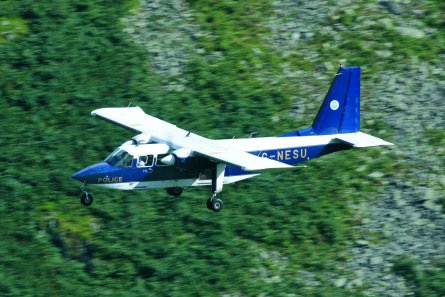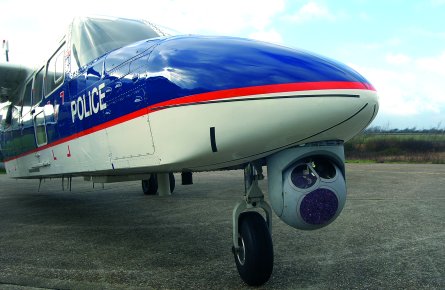By Murdo Morrison in Bembridge
Surrounded by rolling hills and Isle of Wight farmland, Britten-Norman’s Bembridge site must rank as one of the most appealing aerospace factory settings. But the history of the UK’s only remaining major small aircraft builder has been anything but pretty. From its formation in 1953 to the end of the century, the maker of the ubiquitous Islander twin went bust three times and changed hands four times.
|
|---|
Now chief executive William Hynett – who has repositioned the company towards the defence market and product support under its new Omani owners – says there is no prospect of another white knight if his plan fails. “We don’t want to go on through that cycle of tripping up and waiting for someone to come along with a blank cheque,” he says. “My remit is to succeed or to close. For Britten-Norman there aren’t going to be any more second chances.”
Since the 1960s, the BN2 Islander has been a rugged stalwart of remote regions around the world, operating from beaches in the Outer Hebrides to jungle clearings in Indonesia. More than 1,250 of the type have gone into in service around the world – as utility aircraft, passenger aircraft and, as the Defender, in the military surveillance and law-enforcement sphere. At its peak in the early 1970s, the company was delivering over 100 aircraft a year. But when Muscat-based entrepreneur Alawi Sawawi and his brother formed B-N Group in 2000 to salvage what was then a dying business, production of Islanders has almost ceased and the company was struggling by on occasional refit and maintenance work. The workforce was just 21.
Longevity backfires
“Our short-sightedness was to build a civil aircraft that lasts for ever,” remarks Hynett wryly. But he is not far wrong. In the 1970s the company mistook barnstorming revenues from what was a simply designed, robust, non-pressurised aircraft as the basis for long-term sustainability. But, says Hynett, the company failed to broaden the business, and once the world had all the Islanders it needed, sales began to slump.
The strategy of Sawawi and Hynett, a former commander of the Royal Navy Sea Harrier evaluation unit who joined Britten-Norman in 2003, has been to reposition the company away from volume production and firmly in the higher-margin defence and law-enforcement sector – where it began to make a name for itself in the 1980s. The company has also opened new revenue streams, launching a training arm and a division, Aero Composites, to build composite parts and take on work for other aircraft manufacturers. Its most significant piece of business has been winning a deal to reassemble Cirrus SR20 and SR22 light aircraft and deliver them to the US company’s European customers. The company has also set up its first North American and Asia-Pacific sales and support offices.
“Before the new owners took over, there really wasn’t a plan,” says Hynett. “The Zawawis’ gameplan was to buy the assets, inject cash and then make it self-sufficient. It was an opportunity for Britten-Norman to really do its own thing, and we’ve been self-sufficient from the beginning. It was a fundamental change to acknowledge that we weren’t going to sell high volumes of low-cost civil aircraft, but concentrate instead on higher-value defence equipment.” He adds: “Rather than pussyfooting around and pretending to be a civilian company, we acknowledged that sales were never going to get back to the 1970s level. But we had a name in the defence market. We are low cost in defence sector terms, and are very responsive to the user community.”
|
|---|
| Britten-Norman says there is no plan B if its strategy to target defence and aftersales service does not work |
Revenues doubled
When Hynett moved in, the target was still to build 12 aircraft a year. Now, the plan is for just three or four. “If we try to do more, we are inadequately resourced,” he says. This year Britten-Norman will complete just two Islanders (including one with a corporate interior) and one Defender for the British Army, together with refit work on in-service army Defenders. Nevertheless, the company’s finances have been turned around, with revenues doubling to £12 million ($21 million) and profits growing tenfold last year, says Hynett. There are now 165 employees, plus contractors, the offices have been refurbished and the entire Bembridge site has a bustle about it.
Britten-Norman has a long pedigree in the defence and security market: it has been selling Lycoming piston-engined Islanders branded as Defenders to military customers since the 1970s, where they serve in a variety of roles including border patrol, counter-terrorism and maritime surveillance. India’s navy, for instance, operates 13. The company’s offering moved up a gezar, however, with the launch of the Defender 4000 at the Farnborough air show in 1994. The aircraft has 400hp (300kW) Rolls-Royce 250-B17F-engines, a 1m (3ft) longer cabin, bigger wing and revamped avionics bay. The improvements took maximum endurance from 3.5h to 8h.
|
|---|
| Islanders and Defenders have performed a variety of law enforcement roles since the 1970s |
Order prospects
Under its previous ownership, Britten-Norman sold one aircraft to Ireland and one to Malaysia. In 2003, the British Army ordered four Defender 4000s, and there are “prospects for several more”, says Hynett. The first – ordered as an urgent operational requirement for operational service overseas – was built in nine months and delivered in September 2004. Two more UK police aircraft have taken the number of Defender 4000s deliveries to seven, with the army’s fourth aircraft due for delivery later this year. Hynett describes the Defender 4000 as a “specifically designed surveillance aircraft. Because it is unpressurised, the airframe is designed to be cut for a radar to be fitted. Unlike the [Cessna] Caravan, for instance, it has four underwing hard-points. You could even operate a weaponised version of this,” he says. However, Hynett says the company’s philosophy in the defence sector remains “manufacturing a very low-cost, low-maintenance airframe and letting the customer spend the majority of his money on equipment which we help them install. We don’t solutionise.”
Like any small exporter, Britten-Norman has limited budgets to publicise its products. Hynett tends to rely on customer recommendations. “A lot of marketing comes down to word of mouth,” he says. “Nobody wants a hard sell anyway, so what I tend to do is whisk them off to the operator and they get it – warts and all.” It has begun to get some more help from the UK government’s Defence Export Sales Organisation (DESO), which has traditionally, says Hynett, tended to look after the big primes. “There is a growing awareness in DESO of our product. They’re now beginning to look after the next level down, which is SMEs,” he says.
Britten-Norman was one of the first aerospace converts to outsourcing to a low-cost economy: as part of an offset deal, it moved manufacture of the Islander airframe to state-owned Romanian manufacturer Romaero in the late 1960s, where the aircraft has been built ever since. The aircraft are either transported by road or flown to the Isle of Wight with a ferry installation.Although Bembridge has the capacity to manufacture complete aircraft, it makes more sense to continue to subcontract, says Hynett. “We don’t do metal bending. We want to stick to value-added stuff.”
The company has begun to focus much more on marketing, aftersales and added-value services. It has hived off its maintenance and refurbishment business to focus more clearly on the customer, and has launched a training company offering type-rated instruction, engineering courses and even consultancy services.
Overseas presence
Britten-Norman has also set up “embryonic” overseas sales and support units in Miami, Florida and New South Wales, Australia. Although these are “arms length” from Britten-Norman, it is the first time the company has had regional representation. “We had no support footprint before,” says Hynett. “It cuts out the time-zone issues.”
He adds: “We have two ongoing tasks in the company. One is to concentrate on what we’re good at. The second is to reach out for customer support. Two thirds of the 1,250 aircraft we have delivered are still out there.”
Highs and lows: Britten-Norman's turbulent history. 1947 – John Britten and Desmond Norman meet at DH Aeronautical Technical School and go on to found Britten-Norman Ltd six years later; 1966 – Prototype crashes in the Netherlands, killing test pilot Peter Hillwood; 1967 – Islander receives UK and US certification; 1968 – Production agreement signed with Romanians; 1969 – 100th Islander delivered; 1971 – BN-2 Defender launched at Paris air show; months later company goes into receivership; 1972 – Fairey buys company; 1974 – 500th Islander delivered; 1976 – Founders John Britten and Desmond Norman both leave the company; 1977 – Britten-Norman goes into receivership again; 1978 – Pilatus buys company; 1982 – 1,000th Islander delivered; 1988 – $10 million earmarked to develop Defender 4000; 1994 – Defender 4000 launched at Farnborough; 1997 – First Defender 4000 enters service with Ireland’s Garda Air Support Unit; 1997 – Pilatus Britten-Norman bought by Biofarm; 2000 – Britten-Norman goes into liquidation and is bought by Zawawi family; 2004 – UK MoD places urgent order for Defender 4000; 2005 – US arm starts trading; Aero Composites formed. |
|---|
Source: Flight International



















